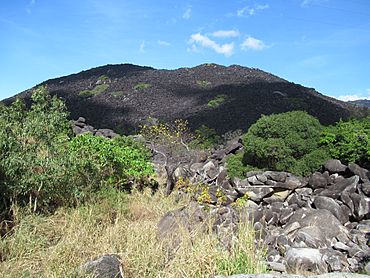Kalkajaka National Park facts for kids
Quick facts for kids Kalkajaka National ParkQueensland |
|
|---|---|
|
IUCN Category II (National Park)
|
|

View of one of the park's mountains from Mulligan Highway
|
|
| Nearest town or city | Cooktown |
| Established | 1980 (Register of the National Estate) |
| Area | 7.81 km2 (3.0 sq mi) |
| Managing authorities | Queensland Parks and Wildlife Service |
| Website | Kalkajaka National Park |
| See also | Protected areas of Queensland |
Kalkajaka National Park is a special protected area in Queensland, Australia. It covers about 781 hectares (that's like 1900 acres!). This park is famous for its huge, dark granite boulders. Some of these rocks are as big as houses! It's a place with amazing nature and many old stories.
Contents
Where is Kalkajaka National Park?
The park is located about 25 kilometers (15 miles) southwest of Cooktown. It is managed and protected as a national park. This means its unique features are kept safe for everyone.
The most amazing part of the park is its giant granite boulders. They are stacked up to form mountains. There is almost no soil between these rocks. This creates a confusing maze of gaps and tunnels. You can sometimes go deep inside the mountain through these passages. But be careful, the rocks can get very hot!
This area has many local stories about people getting lost. The Mulligan Highway runs along the western edge of the park.
How the Black Mountains Were Formed
The park's unique black boulders are made of a type of rock called granodiorite. This rock is mostly white or grey. It formed from magma (melted rock) that slowly cooled down deep inside the Earth. This happened a very long time ago, between 259 and 251 million years ago.
Over millions of years, the softer ground above this cooled magma wore away. This left the hard, fractured rock exposed as mountains. A thin layer of tiny blue-green algae grows on the rocks. This algae makes the grey granite look black. When cold rain falls on the hot, dark rocks, it can make them crack and break apart. Sometimes, this even happens with a loud sound!
Stories and Legends of Kalkajaka
Kalkajaka means "Black Mountain" in the language of the Kuku Nyungkal people. For them, this mountain is a very important place. Its name also means "place of the spear."
The Kuku Nyungkal people have many old stories about the mountain. There are at least four special places on it:
- Kambi: A large rock with a cave where flying-foxes live.
- Julbanu: A big rock shaped like a grey kangaroo, looking towards Cooktown.
- Birmba: A stone facing towards Helenvale, where sulphur-crested cockatoos are seen.
- Yirrmbal: A special, sacred place near the bottom of the mountain.
When European settlers arrived, they also added their own stories to the area. Many tales are told about people, horses, and even groups of cattle disappearing into the maze of rocks. It is thought that those who vanished might have fallen into deep cracks under the rocks. Or they might have gotten lost after going into one of the many passages.
Amazing Animals of Kalkajaka
Kalkajaka National Park is at the very northern end of the Wet Tropics World Heritage Area. This is where wet rainforests meet drier woodlands. This mix of environments makes it a special safe place for rare animals. These animals once lived in more places but now only survive here.
The unique "Black Mountain" environment is the only home in the world for at least three special animals:
- The Black Mountain boulderfrog (Cophixalus saxatilis)
- The Black Mountain skink (Carlia scirtetis)
- The Black Mountain gecko (Nactus galgajuga)
This makes Kalkajaka one of Australia's most important places for animals found nowhere else.
Visiting Kalkajaka National Park
You cannot camp inside Kalkajaka National Park. There are no walking paths or places for picnics. However, there is a special viewing platform. It has signs that tell you more about the park's history and nature.
Gallery
See also
 In Spanish: Parque nacional Montaña Negra para niños
In Spanish: Parque nacional Montaña Negra para niños




